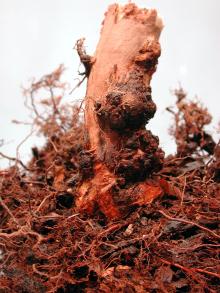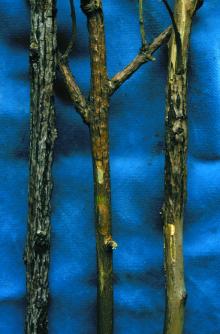Cause The bacteria Agrobacterium tumefaciens has been found in the PNW while A. rubi was reported from Argentina. It is not known if A. rubi, found on caneberries in the PNW, is a problem in blueberry fields in the PNW. Both pathogens survive in soil and infect plants through wounds. Catcher plates on mechanical harvesters can wound canes sufficiently to initiate galls. The disease is a sporadic problem in propagation beds, young plantings, and a few established fields. Some cultivars seem more susceptible than others.
Symptoms Knobby galls occur on branches, at the bases of canes, and on major roots. These galls may be scattered in discrete masses on infected roots and branches or they may occur in long linear strips of contiguous bumps. Galls can also completely encircle the branch. Young galls are cream-to-light brown and spongy in texture, whereas mature galls become dark brown-to-black and are rough and hard. Size varies from only an eighth-inch across up to 1.6 - 6 inches in size. Plant tissues underneath the gall are white or green, but necrotic tissue develops between individual galls. Proper diagnosis is essential because small galls can be confused with wound-callus tissue or other galls caused by fungi, insects, and nematodes.
Cultural control
- Purchase clean stock, and inspect new plants before planting. Discard any diseased plants.
- Do not plant in previously infested fields, or rotate infested field to grasses or vegetables for 2 to 3 years before replanting blueberry.
- Preplant soil solarization has been helpful in reducing populations of certain soilborne pathogens and weeds in western Oregon. Place clear plastic (preferably anti-condensation film) directly on smooth, rototilled ground, which has been irrigated to field capacity and then allowed to drain for 1-2 days. Bury the edges of the plastic to trap the heat. Solarize for 4-6 weeks (or longer) during the hottest part of the summer, beginning in early- to mid-July.
- When mechanically harvesting, clean and lubricate berry-catching plates frequently during harvest. Use springs with just enough tension to close the catching plates.
- Remove and destroy diseased tissue.
- Prune bushes only during dry weather and frequently disinfest pruning equipment. Use the two pruners method: having one soaking in the solution of choice while using the other; then switch pruners, leaving the one you just used to soak, and the one that had been soaking, to continue pruning. If used as a soak, change solutions every 2 to 3 hours.
Chemical control
- Gallex (ready to use) painted on very young galls to reduce further development. Galls may return the following year or, if treated late, may continue to develop. Tissue surrounding the gall may be injured, especially on younger plants. Prepare the surface by removing soil from around the galled area, and allow the area to dry before application. Not registered in Idaho. 24-hr reentry.
Biological control Cuttings or plant roots may be dipped in a suspension of an antagonistic bacterium before planting. To be effective it must be applied a few hours after wounding. Change solution frequently, because if a set of plants contaminated with other pathogens is dipped, then all succeeding plants dipped into the same container/solution will become contaminated.
- Galltrol-A (Agrobacterium radiobacter K84). Not registered in Idaho. 12-hr reentry. O
Reference Kuzmanović, N., Behrens, P., Idczak, E., Wagner, S., Götz, M., Spröer, C., Bunk, B., Overmann, J., and Smalla, K. 2019. A Novel Group of Rhizobium tumorigenes-Like Agrobacteria Associated with Crown Gall Disease of Rhododendron and Blueberry. Phytopathology 109:1840-1848.




